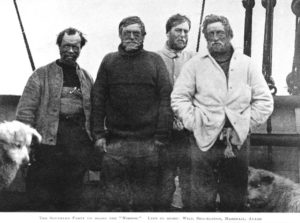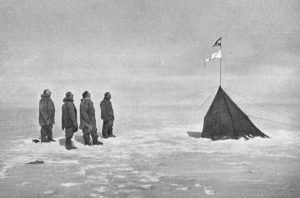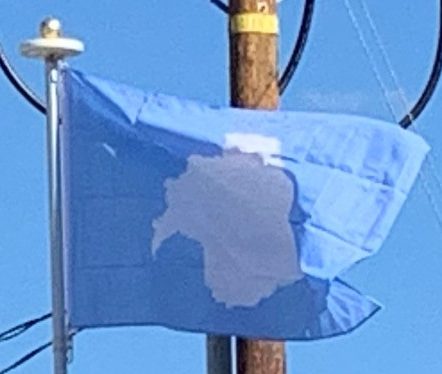
An expedition led by Norwegian polar explorer Roald Amundsen from the ship Fram became the first to reach the geographic South Pole on 14 December 1911, using a route from the Bay of Whales and up the Axel Heiberg Glacier. One month later, the doomed Scott Expedition reached the pole.

Richard E. Byrd led several voyages to the Antarctic by plane in the 1930s and 1940s. He is credited with implementing mechanised land transport on the continent and conducting extensive geological and biological research.The first women to set foot on Antarctica did so in the 1930s with Caroline Mikkelsen landing on an island of Antarctica in 1935, and Ingrid Christensen stepping onto the mainland in 1937.
It was not until 31 October 1956, that anyone set foot on the South Pole again; on that day a U.S. Navy group led by Rear Admiral George J. Dufek successfully landed an aircraft there. The first women to step onto the South Pole were Pam Young, Jean Pearson, Lois Jones, Eileen McSaveney, Kay Lindsay and Terry Tickhill in 1969.
The first person to sail single-handed to Antarctica was the New Zealander David Henry Lewis, in 1972, in the 10-metre steel sloop Ice Bird.
On 28 April 1979, Air New Zealand Flight 901, a McDonnell Douglas DC-10-30, crashed into Mount Erebus, killing all 257 people on board.
In the southern Hemisphere Summer of 1996/97 Børge Ousland became the first human to cross Antarctica alone from coast to coast. Ousland got aid from a kite on parts of the distance. All attempted crossings, with no kites or resupplies, that have tried to go from the true continental edges, where the ice meets the sea, have failed due to the great distance that needs to be covered. For this crossing, Ousland also holds the record for the fastest unsupported journey to the South Pole taking just 34 days.

Geography:
Positioned asymmetrically around the South Pole and largely south of the Antarctic Circle, Antarctica is the southernmost continent and is surrounded by the Southern Ocean; alternatively, it may be considered to be surrounded by the southern Pacific, Atlantic, and Indian Oceans, or by the southern waters of the World Ocean. There are a number of rivers and lakes in Antarctica, the longest river being the Onyx. The largest lake, Vostok, is one of the largest sub-glacial lakes in the world. Antarctica covers more than 5,400,000 square miles, making it the fifth-largest continent, about 1.3 times as large as Europe. The coastline measures 11,165 miles and is mostly characterized by ice formations
Antarctica is divided in two by the Transantarctic Mountains close to the neck between the Ross Sea and the Weddell Sea. The portion west of the Weddell Sea and east of the Ross Sea is called West Antarctica and the remainder East Antarctica, because they roughly correspond to the Western and Eastern Hemispheres relative to the Greenwich meridian.
